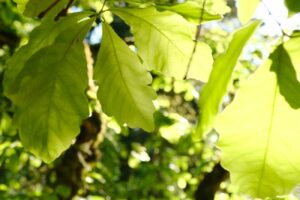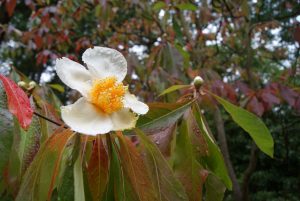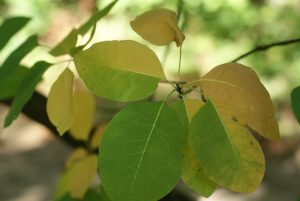October 2023 lived up to our best fall expectations! The vine maples were vibrant and red all over the Arboretum, but especially along Bristlecone Pine Trail, the ginkgos turned saffron yellow and fan-shaped leaves lined our paths, and the Maple Trail was fully ablaze by the end of the month.
Trees to See!

Oaks are often considered keystone species in the diverse habitats they are native to. Hoyt Arboretum is home to 60 species of oak from around the world, mostly planted along Oak Trail. There are many beautiful and diverse oaks that thrive in our northern Oregon climate, but only 1 is native: the Oregon white oak (Quercus garryana).
Take a self-guided tour of 5 important North American white oaks in our collection. Pick up a guide at our Visitor Center or learn more HERE.
Franklin trees are identified by their glossy, long, drooping leaves. In autumn, they produce white flowers with clustered yellow stamens which contrast the leave’s deep reds and purples. The flowers’ sweet scent is often compared to a honey suckle. This species is extinct in the wild and currently listed as endangered.
Location: Wildwood Trail near Vietnam Veterans Memorial
Native to the Midwest, the American smoke wood gets its name from the shed flower stalks its most known for during the summer season. But in the fall, the tree’s egg-shaped leaves develop an astounding show of a watercolor-like display in greens, yellows, purples, oranges, and reds.
Location: Near the intersection of the Wildwood Trail and Hawthorn Trail
Stay Up-To-Date with Hoyt Arboretum!
Subscribe to our email newsletter
AND


